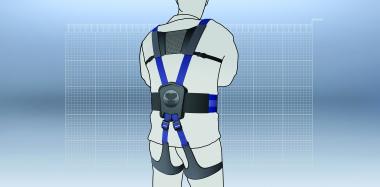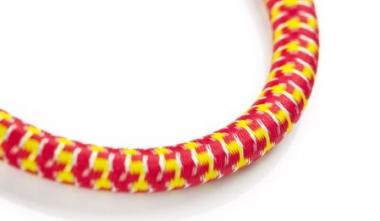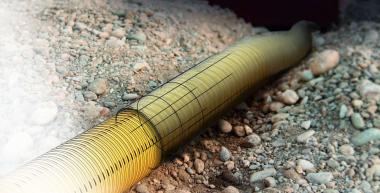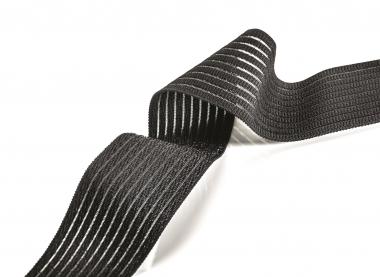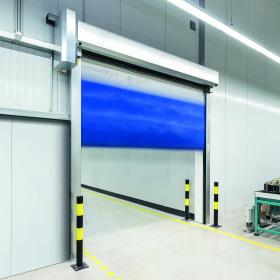Gurt- und Sicherheitsbänder in kreativen Händen
Hängende Hochbeete, Organisationshelfer für zu Hause, die Werkstatt oder unterwegs und Bausätze für modische Taschen: Studierende aus dem sechsten und siebten Semester Textil- und Bekleidungstechnologie an der Hochschule Albstadt-Sigmaringen haben aus Gurt- und Sicherheitsbändern der Firma Carl Stahl aus Herbrechtingen innovative Produkte entwickelt. Bei der öffentlichen Abschlusspräsentation des Industrieprojekts beeindruckten sie die anwesenden Unternehmensvertreter ebenso wie das interessierte Publikum.
Die Studentin Sarah Sturm erklärte die Aufgabenstellung des von Prof. Manuela Bräuning betreuten Projekts: „Wir sollten neue Anwendungen für Gurtbänder finden.“ Diese fallen normalerweise nicht gerade durch kreative Nutzung auf, doch das Unternehmen möchte sich neue Absatzmärkte für seine Produkte erschließen – so kam die Zusammenarbeit mit der Hochschule zustande. Die Studierenden führten zu Beginn des Semesters zunächst eine Marktrecherche durch und sammelten erste Ideen. Anschließend verfolgten drei Gruppen ihre Ansätze.
Das „Team Grün“ beschäftigte sich mit dem Trendthema Urban Gardening. Für Menschen mit wenig Platz und ohne Garten entwickelten sie ein mehrstöckiges hängendes Hochbeet, das in der Wohnung ebenso genutzt und angebracht werden kann wie beispielsweise auf dem Balkon. Rankhilfen sind flexibel einbaubar, und auch an eine künstliche Beleuchtung zur Wachstumsförderung haben die Studierenden gedacht. Die Größe ist veränderbar, und dank der robusten Materialien der Firma Stahl ist das Hochbeet stabil, wetterbeständig und leicht.
Das „Team Tasche“ entwarf verschiedene Bausätze samt Anleitungen für Taschen, die zu Hause selber zusammengesetzt werden. „Uns war die Nachhaltigkeit unserer Produkte sehr wichtig“, erklärte die Studentin Klara Rauscher. „Deshalb werden für die Taschen nur Restposten der Firma Stahl benutzt.“ Die Taschen sind langlebig und sehr robust und können ohne Nähmaschine und Vorkenntnisse in rund einer Stunde gefertigt werden.
Das „Team Orga“ entwickelte schließlich eine Organisationswand, die aus Gurt- und Gummibändern von Hand gewebt wurde. Sie kann zu Hause ebenso aufgehängt werden wie in der Werkstatt oder auch im Transporter und bietet jede Menge Stauraum für Werkzeug, Schreibsachen, Fotos und etliches mehr. „Alle Gurtbänder kommen von Carl Stahl, und unser Produkt kann an Wänden und fast allen anderen Oberflächen angebracht werden“, erklärte die Studentin Tugce Sarikaya.
Frank Bez, Leiter der Entwicklungsabteilung bei Carl Stahl, zeigte sich nach der Abschlusspräsentation der Studierenden komplett begeistert: „Sie hatten wirklich sensationelle Ideen. Ich bin überrascht, was man aus unseren Produkten alles machen kann“, sagte er. „Es ist immer etwas Besonderes aus etwas Kleinem etwas Großes zu machen und einem Gurtband so viel Leben einzuhauchen.“ Er hofft nun, dass der ein oder andere seine Ideen noch weiter vorantreiben möchte, „vielleicht in Form einer Bachelorarbeit“, und bedankte sich im Namen des Unternehmens für das gelungene Projekt.
Studierende Hochschule Albstadt-Sigmaringen HS Albstadt-Sigmaringen Schmaltextilien Carl Stahl
Hochschule Albstadt-Sigmaringen




